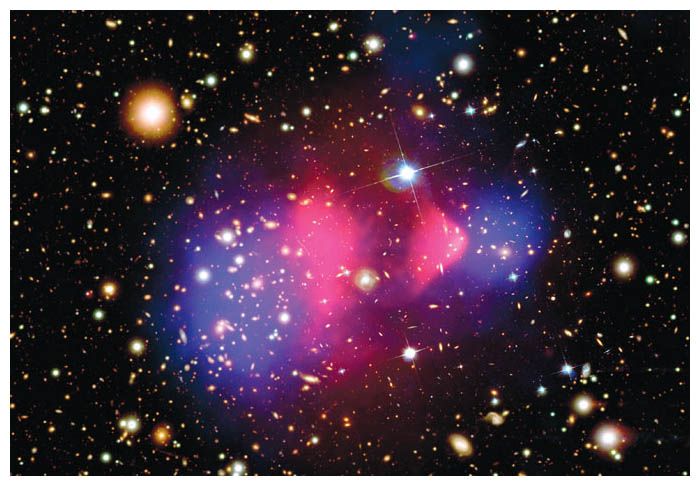
This Article From Issue
January-February 2016
Volume 104, Number 1
Page 55
DOI: 10.1511/2016.118.55
DARK MATTER AND THE DINOSAURS: The Astounding Interconnectedness of the Universe. Lisa Randall. xviii + 414 pp. Ecco, 2015. $29.99.
“I’ll tell you right up front that I don’t yet know if this idea is correct.” Lisa Randall issues her disclaimer proudly, loudly, and—yes—up front, early in the book’s introduction. She is both a prominent physics theorist at Harvard University and a rising star in the world of science popularization, so she fully appreciates the importance of being transparent about the limits of knowledge. Such openness is especially crucial when exploring a bold idea, which is most definitely the case here.

NASA/CXC/CfA/M.Markevitch et al.; Optical: NASA/STScI; Magellan/U.Arizona/D.Clowe et al.; Lensing Map: NASA/STScI; ESO WFI; Magellan/U.Arizona/D.Clowe et al.
Randall’s engrossing tale begins with the enigma of dark matter, an unseen substance that permeates the universe. It makes its presence known only by its gravitational influence on the motions of galaxies, but that pull is tremendous. Current research suggests dark matter outweighs conventional stuff (stars, planets, people, and the like) by about 5 to 1. Yet scientists still have no idea what dark matter is. It is so little understood that Randall objects to the name dark matter , since it is not dark in the conventional sense. If it were right in front of you—which it very well may be—you could not see it. She therefore prefers the more accurate but less poetic transparent matter .
Her story only gets more exotic from there. Instead of being composed of one kind of substance, dark matter may consist of two or more dark entities. One of these may have complex properties that allow it to form organized structures, such as a flat disk resembling a vinyl record embedded within our galaxy. That disk might periodically disrupt our Solar System, sending swarms of comets buzzing toward Earth. One of those comets might have struck our planet 65 million years ago, triggering the extinction of the dinosaurs—the concept that yields the conclusion promised in the book’s title.
Randall explores the connections with earnest curiosity. Despite her best instincts, though, she gets swept away by her ideas at times; each link in the chain is full of uncertainty, and her caveats are not always weighty enough to balance out her conjectures. It’s worth repeating that the only fully proven part of the argument is that the universe exhibits an unexplained gravitational perturbation on large scales. But Randall’s true goal here is exploration, not proof. Did dark matter kill the dinosaurs? Probably not. Will you learn a great deal about science and the scientific method from her book? Unless you are already an expert in cosmology, paleontology, and particle physics, the answer is a resounding, 100 percent yes.
American Scientist Comments and Discussion
To discuss our articles or comment on them, please share them and tag American Scientist on social media platforms. Here are links to our profiles on Twitter, Facebook, and LinkedIn.
If we re-share your post, we will moderate comments/discussion following our comments policy.